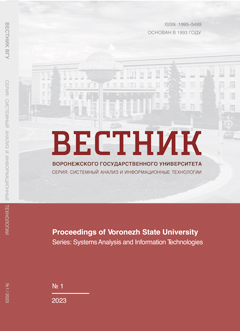Методы машинного обучения для задач прогнозирования и максимизации выработки электроэнергии солнечной электростанции
Аннотация
Системы прогнозирования и максимизации выработки электроэнергии солнечной электростанции на основе методов машинного обучения повышают эффективность солнечной электростанции и, таким образом, актуальны в соответствии с приоритетным направлением развития науки, технологий и техники в РФ, с приоритетом государственной энергетической политики «Энергетической стратегии на период до 2035 года» и утвержденными правительственной комиссией по высоким технологиям и инновациям технологическими платформами: «Интеллектуальная электроэнергетическая система России», «Малая распределённая энергетика». Системы выработки электроэнергии солнечной электростанции имеют сложную нелинейную динамику с неопределенностями, обусловленными изменением параметров системы и флуктуациями инсоляции. Таким образом, аппроксимировать эту сложную динамику классическими алгоритмами с заданной точностью нельзя, в то время как алгоритмы машинного обучения обеспечивают требуемую точность. Методы машинного обучения становятся ключевыми элементами современных систем прогнозирования и максимизации выработки электроэнергии солнечной электростанции в связи с растущим спросом на высокопроизводительный анализ данных с целью повышения эффективности и надежности солнечной электростанции. При решении задач прогнозирования и максимизации выработки электроэнергии солнечной электростанции алгоритмы машинного обучения в сравнении с традиционными алгоритмами обеспечивают следующие преимущества: требуемую точность решения указанных задач; безопасное и эффективное управления электрическими сетями, интегрирующими солнечные электростанции. В отличие от других обзорных статей, наше исследование: кратко обобщает наши интеллектуальные самоадаптирующиеся интеллектуальные системы прогнозирования и максимизации выработки электроэнергии солнечной электростанции; обобщает аналитический обзор в таблицах, отражающих сравнительный анализ качества, в том числе точности, систем прогнозирования и максимизации выработки электроэнергии солнечной электростанции на основе алгоритмов машинного обучения; оценивает перспективы будущей цифровой трансформации солнечной энергетики в умную солнечную энергетику на основе интегрированных передовых технологий, в том числе машинного обучения.
Скачивания
Литература
2. Technological platform “Intelligent electric power system of Russia” / Official website of the Federal State Budgetary Institution “REA”. Text: electronic. http://rosenergo.gov.ru/regulations_ and_methodologies/tehnologicheskaya_platforma_tp_ies. Accessed: 15.11.2022.
3. Technological platform “Small distributed energy” / Official website of CJSC “Agency for forecasting balances in the electric power industry”. 2019. Text: electronic: http://www.e-apbe. ru/distributed_energy/. Accessed: 15.11.2020.
4. Gaviria J. F. [et al.] (2022) Machine learning in photovoltaic systems: A review. Renewable Energy. No 196. P. 298–318.
5. Wu Y. K. [et al.] (2022) Completed Review of Various Solar Power Forecasting Techniques Considering Different Viewpoints. Energies. No 15. P. 332.
6. Engel E. A. and Engel N. E. (2021) Automatic adaptation of a Solar Plant Intelligent Control System. Journal of Physics: Conference Series. P. 1889.
7. Engel E. A. and Engel N. E. (2021) Intelligent prediction of electricity generated by a photovoltaic system. Bulletin of the Khakass State University. N. F. Katanov. No 1. P. 65–69.
8. Engel E. A. and Engel N. E. (2020) Intelligent tracking system for the maximum power point of a photovoltaic array. Bulletin of cybernetics. No 4. P. 21–27.
9. Engel E. A. and Engel N. E. (2019) Tracking system for the maximum power point of a photovoltaic array based on a modified fuzzy neural network. Bulletin of cybernetics. No 3. P. 14–25.
10. Alkhayat G. and Mehmood R. (2021) A review and taxonomy of wind and solar energy forecasting methods based on deep learning. Energy AI. No 4. P. 100060
11. Nespoli A. [et al.] (2019) Day-Ahead Photovoltaic Forecasting: A Comparison of the Most Effective Techniques. Energies. No 12. P. 1621.
12. Khan P. W. Machine Learning-Based Approach to Predict Energy Consumption of Renewable and Nonrenewable Power Sources. Energies. No 13. P. 4870.
13. Grimaccia F. [et al.] (2017) ANN Sizing Procedure for the Day-Ahead Output Power Forecast of a PV Plant. Appl. Sci. No 7. P. 622.
14. Omar M. [et al.] (2016) Day-ahead forecasting for photovoltaic power using artificial neural networks ensembles. In Proceedings of the 2016 IEEE International Conference on Renewable Energy Research and Applications. P. 1152–1157.
15. Das U. K. [et al.] (2019) Forecasting of photovoltaic power generation and model optimization: A review. Renew. Sustain. Energy Rev. No 81. P. 912–928.
16. Akhter M. N. [et al.] (2019) Review on forecasting of photovoltaic power generation based on machine learning and metaheuristic techniques. IET Renew. Power Gener. No 13. P. 1009–1023.
17. Notton G. [et al.] (2019) Some Applications of ANN to Solar Radiation Estimation and Forecasting for Energy Applications. Appl. Sci. № 9. P. 209.
18. Liu L. [et al.] (2017) Forecasting Power Output of Photovoltaic System Using A BP Network Method. Energy Procedia. No 142. P. 80– 786.
19. Suresh V. [et al.] (2020) Forecasting Solar PV Output Using Convolutional Neural Networks with a Sliding Window Algorithm. Energies. No 13. P. 723.
20. Wu Y. K. [et al.] (2022) Completed Review of Various Solar Power Forecasting Techniques Considering Different Viewpoints. Energies. No 15. P. 3320.
21. Tovar M. [et al.] (2020) PV Power Prediction, Using CNN-LSTM Hybrid Neural Network Model. Case of Study: Temixco-Morelos, México. Energies. No 13. P. 6512.
22. Zjavka L. and Snasel V. (2022) PV Energy Prediction in 24 h Horizon Using Modular Models Based on Polynomial Conversion of the L-Transform PDE Derivatives in Node-by-NodeEvolved Binary-Tree Networks. Eng. Proc. No 18. P. 34.
23. Pombo D. V. (2022) Bench-marking physics-informed machine learning-based short-term PV-power forecasting tools. Energy Reports. No 8. P. 6512–6520.
24. Pombo D. V. [et al.] (2022) Increasing the Accuracy of Hourly Multi-Output Solar Power Forecast with Physics-Informed Machine Learning. Sensors. No 22. P. 749.
25. Xiaoying R. [et al.] (2022) Quad-kernel deep convolutional neural network for intra-hour pho-tovoltaic power forecasting. Applied Energy. No 323. P. 119682.
26. Ahn H. K. and Park N. (2021) Deep RNNBased Photovoltaic Power Short-Term Forecast Using Power IoT Sensors. Energies. No 14. P. 436.
27. Wang P. Y. [et al.] (2018) Adaptive Solar Power Forecasting based on Machine Learning Methods. Appl. Sci. No 8. P. 2224.
28. Hossain M. S. and Mahmood H. (2020) Short-Term Photovoltaic Power Forecasting Using an LSTM Neural Network and Synthetic Weather Forecast. IEEE Access. No 8. P. 172524– 172533.
29. Mittal S. A. (2022) Review on forecasting the photovoltaic power Using Machine Learning. Journal of Physics: Conference Series. No 2286. P. 012010.
30. Xing L. [et al.] (2022) Combining transfer learning and constrained long short-term memory for power generation forecasting of newly-constructed photovoltaic plants. Renewable Energy. No 185. P. 1062–1077.
31. Abdellatif A. [et al.] (2022) Forecasting Photovoltaic Power Generation with a Stacking Ensemble Model. Sustainability. No 14. P. 11083.
32. Zhang H. [et al.] (2022) Stacking Model for Photovoltaic-Power-Generation Prediction. Sustainability. No 14. P. 669.
33. Akhter M. N. [et al.] (2022) An HourAhead PV Power Forecasting Method Based on an RNN-LSTM Model for Three Different PV Plants. Energies. No 15. P. 33.
34. Xing L., Dongxiao Z. and Xu Z. (2022) Combining transfer learning and constrained long short-term memory for power generation forecasting of newly-constructed photovoltaic plants. Renewable Energy. No 185. P. 1062–1077.
35. Zjavka L. (2020) PV power intra-day predictions using PDE models of polynomial networks based on operational calculus. IET Renew. Power Gener. No 14. P. 1405–1412.
36. Zhen Z. [et al.] (2020) Deep learning-based surface irradiance mapping model for solar PV power forecasting using sky image. IEEE Trans. Ind. Appl. No 56. P. 3385–3396.
37. Abdel-Nasser M. and Mahmoud K. (2019) Accurate photovoltaic power forecasting models using deep LSTM-RNN. Neural Comput. Appl. No 31. P. 2727–2740.
38. Zhang J. [et al.] (2018) Deep photovoltaic nowcasting. Sol. Energy. No 176. P. 267–276.
39. Hossain M. [et al.] (2017) Application of extreme learning machine for short term output power forecasting of three grid-connected PV systems. J. Clean. Prod. No 167. P. 395–405.
40. Nespoli A. [et al.] (2019) Day-Ahead Photovoltaic Forecasting: A Comparison of the Most Effective Techniques. Energies. No 12. P. 1621.
41. Khan P. W. [et al.] (2020) Machine Learning-Based Approach to Predict Energy Consumption of Renewable and Nonrenewable Power Sources. Energies. No 13. P. 4870.
42. Khan A. [et al.] (2020) A Comparative Study on Solar Power Forecasting using Ensemble Learning. 4th International E3S Web of Conferences. – 2021. – № 309. – P. 01163.
43. Engel E. А. [et al.] (2020) Photovoltaic Applications on the Basis of Modified Fuzzy Neural Net. Solar Irradiance. Types and Applications, In: NOVA SCIENCE PUBLISHERS, ed Daryl M. Welsh. P. 7–87.
44. Engel E.A. [et al.] (2018) Power forecasting for a photovoltaic system based on the multi-agent adaptive fuzzy neuronet. IOP Conf. Series: Materials Science and Engineering. No 450. P. 072012.
45. Mod. J. [et al.] (2018) Photovoltaic yield prediction using an irradiance forecast model based on multiple neural networks. J. Mod. Power Syst. Clean Energy. No 6. P. 255–267.
46. Wang Y. [et al.] (2018) Short-term load forecasting with multi-source data using gated recurrent unit neural networks. Energies. No 11. P. 1138.
47. Pan C. [et al.] (2018) Very Short-Term Solar Generation Forecasting Based on LSTM with Temporal Attention Mechanism. IEEE 5th International Conference on Computer and Communications (ICCC). P. 267–271.
48. Pelland S. [et al.] (2013) Photovoltaic and Solar Forecasting: State of the Art. ArXiv. No 15. P. 1.
49. ESOLMET-IER instituto de energías renovables. Text: electronic. URL
50. Mayer M. J. and Gróf G. (2021) Extensive comparison of physical models for photovoltaic power forecasting. Appl. Energy. No 283. P. 116239.
51. Elieser M. [et al.] (2021) Prediction of site-specific solar diffuse horizontal irradiance from two input variables in Colombia. Heliyon. No 7. P. 08602.
52. Manajit S. [et al.] (2018) The national solar radiation data base (NSRDB). Renewable and Sustainable Energy Reviews. No 89. P. 51–60.
53. Narvaez G. [et al.] (2021) Machine Learning for Site-Adaptation and Solar Radiation Forecasting. Energies. No 167. P. 333–342
54. Belmahdi B. [et al.] (2022) Comparative optimization of global solar radiation forecasting using machine learning and time series models. Environmental Science and Pollution Research. No 29. P. 14871–14888
55. Faisal A. N. [et al.] (2022) Neural networks based multivariate time series forecasting of solar radiation using meteorological data of different cities of Bangladesh. Results in Engineering. No 13. P. 100365.
56. Guermoui M. [et al.] (2022) A novel ensemble learning approach for hourly global solar radiation forecasting. Neural Computing and Applications. No 34. P. 2983–3005
57. Acikgoz H. (2022) A novel approach based on integration of convolutional neural networks and deep feature selection for short-term solar radiation forecasting. Applied Energy. No 305. P. 117912
58. Engel E. A. and Kovalev I. V. (2017) Solar Irradiance Forecasting Based on the Multi-agent Adaptive Fuzzy Neuronet. Advances in Swarm Intelligence. No 10386. P. 135-140.
59. Kumari P. and Toshniwal D. (2022) Extreme gradient boosting and deep neural network-based ensemble learning approach to forecast hourly solar irradiance. Journal Clean. Prod. No 279. P. 123285.
60. Kofinas P. [et al.] (2017) A reinforcement learning approach for MPPT control method of photovoltaic sources. Renewable Energy. No 108. P. 461–473.
61. Bag A., Subudhi B. and Ray P. K. (2019) A combined reinforcement learning and sliding mode control scheme for grid integration of a PV system. CSEE Journal of Power and Energy Systems. No 5. P. 498–506.
62. Bavarinos K. [et al.] (2021) Maximum Power Point Tracking Based on Reinforcement Learning Using Evolutionary Optimization Algorithms. Energies. No 14. P. 335.
63. Kalogerakis C. [et al.] (2020) Global MPPT Based on Machine-Learning for PV Arrays Operating under Partial Shading Conditions. Appl. Sci. No 10. P. 700.
64. Phan B. C. [et al.] (2020) A Deep Reinforcement Learning-Based MPPT Control for PV Systems under Partial Shading Condition. Sensors. No 20. P. 3039.
65. Lapan M. (2018) Deep Reinforcement Learning Hands-On: Apply modern RL methods, with deep Q-networks, value iteration, policy gradients, TRPO, AlphaGo Zero and more. Packt Publishing Ltd.
66. Chou K. Y., Yang S. T. and Chen Y. P. (2018) Maximum Power Point Tracking of Photovoltaic System Based on Reinforcement Learning. Sensors. No 19. P. 5054.
67. Bouarroudj N. [et al.] (2019) Maximum power point tracker based on fuzzy adaptive radial basis function neural network for PV-system. Energies. No 2. P. 2827.
68. Engel E. A. and Engel N. E. (2021) Solar Plant Intelligent Control System Under Uniform and Non-uniform Insolation Advances in Neural Computation. Studies in Computational Intelligence. No 925. P. 374–380.
69. Avila L. [et al.] (2020) Deep reinforcement learning approach for MPPT control of partially shaded PV systems in smart grids. Applied Soft Computing. No 97. P. 106711.
70. Keyrouz F. (2018) Enhanced Bayesian based MPPT controller for PV systems. IEEE Power and Energy Technology Systems Journal. No 5. P. 11–17.
71. Behera M. K. [et al.] (2018) Solar photovoltaic power forecasting using optimized modified extreme learning machine technique. Engineering Science and Technology. No 21. P. 428–438
72. Awais M. [et al.] (2020) Nonlinear adaptive NeuroFuzzy feedback linearization based MPPT control schemes for photovoltaic system in microgrid. PLoS ONE. No 15. P. 0234992.
73. Hassan S. Z. [et al.] (2017) Neuro-Fuzzy Wavelet Based Adaptive MPPT Algorithm for Photovoltaic Systems. Energies. No 10. P. 394.
74. Eltamaly A. M. [et al.] (2018) Performance of MPPT techniques of photovoltaic systems under normal and partial shading conditions. Advances in renewable energies and power technologies. P. 115–161.
75. Messalti S. [et al.] (2015) A new neural networks MPPT controller for PV systems. The Sixth International Renewable Energy Congress. P. 1–6.
76. Arjun M. [et al.] (2018) Artificial neural network-based hybrid MPPT for photovoltaic modules. In 2018 International CET Conference on Control Communication and Computing. P. 140–145.
77. Haider S. A. [et al.] (2017) Artificial neural network based maximum power point tracking for solar photovoltaics. International Conference on Information and Communication Technologies (ICICT). P. 150–155.
78. OpenAI. Gym A toolkit for developing and comparing reinforcement learning algorithms. Text: electronic. URL
79. Avila M. [et al.] (2019) MPPT for PV systems using deep reinforcement learning algorithms. IEEE Latin America Transactions. No 17. P. 2020–2027.
- Авторы сохраняют за собой авторские права и предоставляют журналу право первой публикации работы, которая по истечении 6 месяцев после публикации автоматически лицензируется на условиях Creative Commons Attribution License , которая позволяет другим распространять данную работу с обязательным сохранением ссылок на авторов оригинальной работы и оригинальную публикацию в этом журнале.
- Авторы имеют право размещать их работу в сети Интернет (например в институтском хранилище или персональном сайте) до и во время процесса рассмотрения ее данным журналом, так как это может привести к продуктивному обсуждению и большему количеству ссылок на данную работу (См. The Effect of Open Access).



















